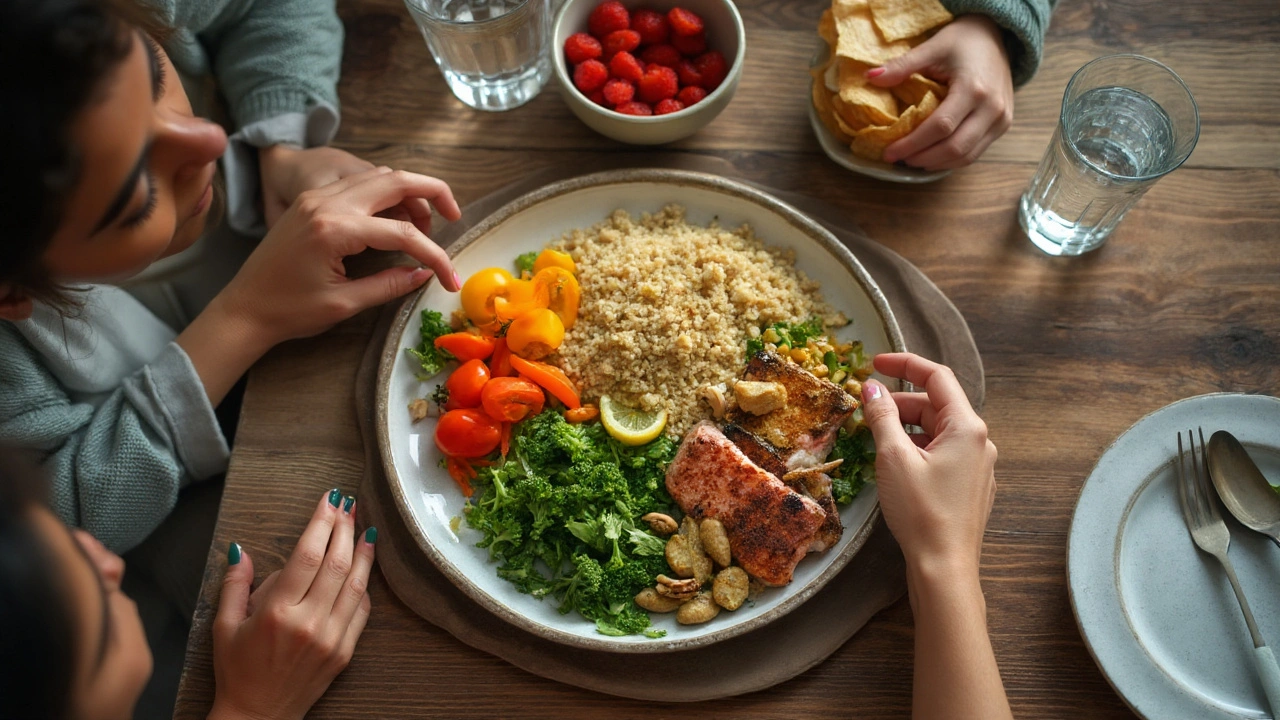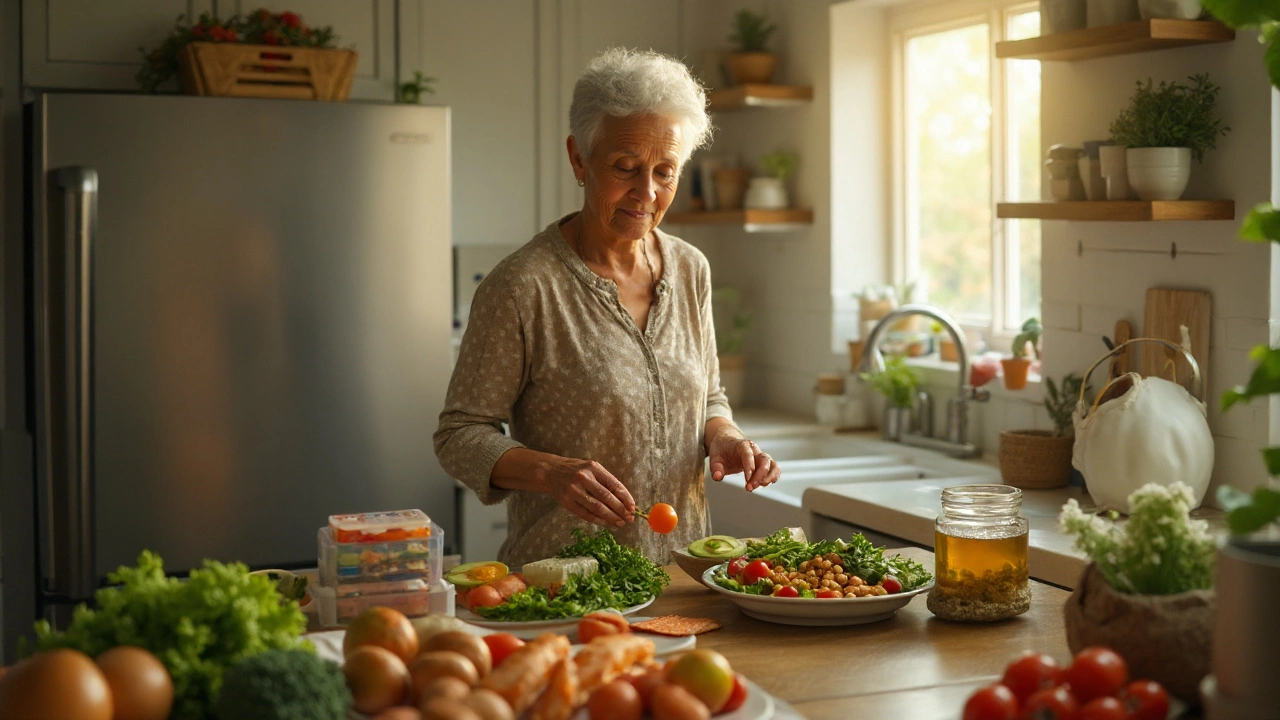Here’s the straight talk: food won’t replace blood thinners or cure a clot, but the right eating pattern can tilt the odds in your favor. Deep vein thrombosis (DVT) hits about 1-2 in 1,000 adults each year, and risk climbs with age, immobility, surgery, hormones, and weight. Your goal isn’t a magic ingredient. It’s a daily pattern that lowers inflammation, keeps blood moving, supports a healthy weight, and plays nice with your meds.
TL;DR
- Think Mediterranean-style: fish, olive oil, beans, whole grains, nuts, and lots of plants. Aim for 2-3 serves of oily fish weekly.
- Go big on fiber (25-30 g/day), hydrate, and limit ultra-processed salty/sugary foods that push up blood pressure and weight.
- If you take warfarin, keep vitamin K intake consistent (not low). Don’t yo-yo your greens.
- On newer blood thinners (DOACs), avoid grapefruit and St John’s wort; check labels and ask your pharmacist.
- Diet helps, movement seals the deal: stand, stretch, and walk-especially on long flights.
What food can (and can’t) do for clot risk
I’m writing from Melbourne, and if you’ve ever flown to London from here, you know what a long-haul does to your legs. Food can’t undo 20 hours of sitting, but it can tweak the biology that matters: blood vessel health, inflammation, fluid balance, and weight. That’s your leverage.
“Deep vein thrombosis (DVT) is a blood clot that forms in a deep vein, usually in the leg.” - Centers for Disease Control and Prevention (CDC)
What diet can help with:
- Inflammation and endothelial health: omega-3s, polyphenols (berries, olive oil, tomatoes), and fiber support the vessel lining so platelets and clotting factors are less trigger-happy.
- Blood viscosity and flow: hydration matters. Thick, concentrated blood flows slower; slower flow means higher clot risk, especially when you’re inactive.
- Weight and blood pressure: excess weight and high blood pressure raise VTE risk; a plant-forward pattern helps both.
What diet can’t do:
- It won’t replace anticoagulants after a clot. Guidelines from the American College of Chest Physicians (CHEST) are clear: anticoagulation is the cornerstone of treatment and prevention after DVT/PE.
- It can’t erase risks like major surgery, cancer, or genetic thrombophilias. It can only support your baseline.
Evidence in plain terms: large trials on diet focus more on heart disease than DVT, but the same anti-inflammatory foods that protect arteries support veins too. Public health agencies (CDC, WHO) and hematology groups consistently recommend staying active, maintaining a healthy weight, and eating a balanced, minimally processed diet as part of a risk-reduction plan.
Build a clot-smart plate (step-by-step)
Here’s a simple framework I use at home (and on those long-hauls when Amelia and I pack snacks). It’s not a diet to “start”-it’s a plate you can build at every meal.
-
Start with hydration. Your easy target: pale-yellow urine by midday. As a rule of thumb, 30-35 mL/kg/day of fluids (water, sparkling water, herbal tea, broth). On flights, drink 250-500 mL each hour you’re awake. Alcohol dehydrates-go easy.
-
Base of fiber. Fill a quarter to a third of your plate with whole grains or legumes. Think oats, barley, brown rice, quinoa, chickpeas, or lentils. Fiber keeps weight and blood sugar steady and feeds gut microbes that produce anti-inflammatory compounds.
-
Protein with a pro-clot profile. Two to three serves of oily fish per week (salmon, sardines, mackerel, herring) for EPA/DHA. On other days, beans, tofu, eggs, or poultry. Red meat? Small portions, less often.
-
Plants in color. Half the plate as vegetables and fruit: dark leafy greens, tomatoes, capsicum, broccoli, carrots, berries, citrus. Polyphenols are your friend. If you’re on warfarin, keep greens consistent, not absent-more on that below.
-
Fat that helps, not hinders. Extra-virgin olive oil as your main fat. Add a small handful of nuts most days (walnuts, almonds) and seeds (flax, chia) for ALA omega-3s. Avoid trans fats and trim saturated fat.
-
Season smart. Turmeric (with black pepper for absorption), ginger, garlic, cinnamon. These bring flavor and a gentle anti-inflammatory nudge. Use them in cooking; be cautious with high-dose supplements if you’re on anticoagulants.
-
Watch salt and sugar. Canned soups, instant noodles, deli meats, and snack foods spike sodium. High added sugar (soft drinks, pastries) drives weight gain and inflammation. Read labels.
-
Alcohol: two rules. If you drink, keep it light and with food; avoid binge patterns. Alcohol can interact with warfarin and boosts bleeding risk on any blood thinner.
Sample day that ticks the boxes:
- Breakfast: Oats with chia and blueberries, Greek yogurt, and a drizzle of olive oil; or wholegrain toast with smashed avocado, tomato, and a poached egg.
- Lunch: Salmon and barley salad with rocket, tomato, cucumber, olives, and olive oil-lemon dressing; or lentil soup with a side of wholegrain bread.
- Snack: A pear and a handful of walnuts; or carrot sticks with hummus.
- Dinner: Grilled mackerel, roasted sweet potato, and a big plate of mixed veg; or tofu stir-fry with broccoli, capsicum, ginger, and brown rice.
- Drink cues: Water bottle on your desk; herbal tea mid-morning and mid-afternoon.
Travel tweak (Melbourne-Perth or Melbourne-Singapore): pack a large water bottle, compression socks, and high-fiber snacks (roasted chickpeas, almonds, an apple). Get up every 60-90 minutes. I set a phone timer and walk the aisle. It’s not glamorous; it works.

Foods that help vs foods to limit
These choices work because of how they affect inflammation, fluid balance, and vessel function. No single food is magic; the pattern is.
Foods that help
- Oily fish: salmon, sardines, mackerel, herring. EPA/DHA support endothelial function and a balanced inflammatory response.
- Nuts and seeds: walnuts, almonds, flax, chia. Fiber, ALA omega-3, magnesium.
- Extra-virgin olive oil: rich in polyphenols like oleocanthal; use for dressings and low-medium heat cooking.
- Legumes and whole grains: chickpeas, lentils, beans, oats, barley, quinoa-fiber for weight and metabolic health.
- Colorful fruit and veg: berries, citrus, tomatoes, leafy greens, broccoli, capsicum-polyphenols and nitrates that support vessels.
- Fermented dairy or soy: yogurt, kefir, tempeh for gut microbiome support.
- Spices and herbs: turmeric, ginger, garlic, cinnamon, rosemary. Use in cooking, not megadose pills if you’re anticoagulated.
- Beverages: water, sparkling water, herbal tea; coffee in moderation is fine for most people.
Foods to limit
- Ultra-processed salty snacks and instant meals: they jack up sodium and blood pressure.
- Processed meats and frequent fried foods: push inflammation and weight.
- Sugary drinks and desserts: add calories fast without nutrients.
- Heavy cream sauces and pastries: saturated fat without fiber.
- Energy drinks: dehydrating, often high in sugar and caffeine-bad combo on long, sedentary days.
Medication-food cautions you shouldn’t ignore
- Warfarin: vitamin K reduces its effect; consistency is key. Alcohol binges swing your INR. Many herbal products interact (ginkgo, St John’s wort). Always check with your pharmacist.
- DOACs (apixaban, rivaroxaban, dabigatran, edoxaban): avoid grapefruit and Seville orange; watch pomegranate and St John’s wort. Take dabigatran with water and keep the capsule intact.
| Medicine | Key food interactions | Practical tip |
|---|---|---|
| Warfarin | High vitamin K lowers effect; alcohol binges raise bleeding risk; many herbals interact | Keep greens steady day to day; limit alcohol; check supplements with your pharmacist |
| Apixaban / Rivaroxaban | Grapefruit/Seville orange may raise levels; St John’s wort may reduce effect | Avoid grapefruit; skip St John’s wort; read labels on juices and marmalades |
| Dabigatran | Acid-sensitive; don’t open capsules; alcohol raises bleeding risk | Swallow whole with water; store properly; keep alcohol light |
These cautions are in line with guidance from hematology societies and medicine regulators. When in doubt, your pharmacist is your best shortcut answer.
Warfarin, vitamin K, and how to eat without fear
Vitamin K doesn’t need to scare you. It’s essential for health. The trick with warfarin is consistency: eat a similar amount most days so your dose can be set around your normal plate. Big swings in greens lead to big INR swings.
How to stay consistent
- Pick a daily pattern and stick to it. Example: 1 cup mixed greens at lunch and 1/2 cup cooked broccoli at dinner-every day.
- If you want to eat more greens long-term, that’s fine. Tell your doctor so your dose can be adjusted. Don’t “suddenly get healthy” the week before an INR check.
- Avoid vitamin K megadose supplements unless your care team is on board.
High/medium/low vitamin K quick map (by typical serve)
| Vitamin K level | Common foods | What to do on warfarin |
|---|---|---|
| High (>200 µg per serve) | Kale, spinach, silverbeet, collards, parsley | Okay if consistent; don’t binge or suddenly cut |
| Medium (50-200 µg) | Broccoli, Brussels sprouts, cabbage, asparagus, kiwi | Keep portions stable week to week |
| Low (<50 µg) | Tomatoes, carrots, capsicum, onions, mushrooms, berries, apples, citrus | These are more flexible; still aim for routine |
Note: actual vitamin K varies by variety and cooking method. The category approach keeps it practical and safe.
Supplements? Many “natural” products can nudge clotting or bleeding. Fish oil, turmeric/curcumin, ginkgo, garlic, vitamin E, and high-dose cranberry can interact with blood thinners. Food forms are usually fine; pills are where people get into trouble. Bring your full list to your GP or pharmacist.
If you’re not on warfarin (you’re on a DOAC or no anticoagulant), you don’t need to micromanage vitamin K. Eat greens freely-they’re good for you.

Cheat sheets, FAQs, and your next steps
Here are the quick wins people ask me for, bundled into one place. This is your everyday playbook for a DVT diet.
Quick shopping list
- Fish: salmon, sardines (tinned in olive oil is fine)
- Proteins: eggs, tofu, chickpeas, lentils
- Grains: oats, barley, brown rice, wholegrain bread
- Veg and fruit: leafy greens, tomatoes, broccoli, carrots, berries, citrus
- Healthy fats: extra-virgin olive oil, walnuts, almonds, flax/chia
- Flavor: turmeric, ginger, garlic, pepper, lemon
- Drinks: water, mineral water, herbal tea
One-week template (repeat and rotate)
- Mon/Wed/Fri dinners: fish + whole grain + 2 veg
- Tue/Thu dinners: legume-based (lentil curry, bean chili)
- Weekend: poultry or tofu stir-fry; roast veg tray bake
- Breakfasts: oats or eggs + veg
- Lunches: leftovers or big salad with protein
Long-haul travel checklist (Melbourne flyers, this saves you)
- Compression socks rated 15-20 mmHg
- 1-1.5 L refillable bottle; ask crew to top it up
- Set a 60-90 minute movement alarm; aisle stretches
- Salty snacks out; nuts, fruit, roasted chickpeas in
- Skip alcohol on the plane or keep it to one with a meal
Red flags-get help fast
- New leg swelling, warmth, pain, or redness (one side)
- Sudden chest pain, shortness of breath, or coughing blood
- On blood thinners: black stools, vomiting blood, severe headaches after a fall
Mini‑FAQ
- Do I need to avoid spinach on warfarin? No. Eat it consistently. Your dose is set to your routine intake.
- Is coffee okay? For most, yes. Just keep fluids up and avoid sugary add‑ins. If coffee makes you pee more, add extra water.
- What about green tea? Moderate cups are fine for most. Very high intake may affect warfarin in some people-keep it steady.
- Can I take fish oil with a blood thinner? Food sources of omega‑3 are preferred. High-dose fish oil can raise bleeding risk-ask your doctor first.
- Is turmeric good or bad? As a spice, good. As a high-dose supplement on anticoagulants, risky without medical advice.
- Keto or intermittent fasting? If weight loss helps your risk, fine-but avoid rapid swings in vitamin K intake on warfarin. Plan greens into your eating window.
- Grapefruit-really that big a deal? Yes for some DOACs. It can raise drug levels. Choose other citrus.
Next steps by scenario
- Desk‑based job: Stand or walk 5-10 minutes every hour. Put water on your desk and set calendar nudges.
- After surgery or injury: Follow your surgeon’s movement plan, wear compression if prescribed, eat a protein‑rich, high‑fiber plate to support healing and bowel regularity.
- Pregnant or postpartum: Higher DVT risk window. Focus on hydration, fiber, calcium/iron needs, and regular walking. Get personalized advice from your obstetric team about travel and compression.
- Hot Australian summer: Drink more than you think. Add a pinch of salt to water if you’re sweating heavily and not on a sodium‑restricted plan.
- On warfarin and want to go greener: Decide your new daily green target, tell your clinic, then adjust dose. Don’t change first and hope for the best.
How I keep it real at home
At our place in Melbourne, we keep a “default dinner”: tinned sardines, cherry tomatoes, olive oil, lemon, and a grain-on the table in under 10 minutes. If life gets messy, that default anchors the week. Amelia laughs that it’s not fancy, but it hits the nutrients that matter and lets us move on with the evening.
Why this works
The pattern above lines up with public guidance from the CDC, WHO, and Australian health authorities: stay active, maintain a healthy weight, eat plenty of plants, choose healthy fats, and minimize ultra‑processed foods. Hematology groups (like the American Society of Hematology and CHEST) emphasize that diet supports but doesn’t replace anticoagulation when it’s indicated. That’s the mindset that keeps you safe.
Important: This is general information, not medical advice. If you’ve had a clot, if you’re on anticoagulants, or if you’re preparing for surgery or pregnancy, loop in your GP, haematologist, or pharmacist. They can tailor these rules to you.

Krishna Chaitanya
September 5, 2025 AT 19:56Whoa this diet guide is like a superhero cape for veins!
diana tutaan
September 5, 2025 AT 20:06The guide is thorough but it glosses over sodium limits. Consistency with vitamin K is crucial for warfarin patients.
Sarah Posh
September 5, 2025 AT 20:30I love how you broke down the diet into easy steps.
The focus on hydration right at the start is spot on.
Keeping fiber intake high helps both weight and blood flow.
Including oily fish several times a week gives the body essential omega‑3s.
Using olive oil as the main fat adds polyphenols that protect vessels.
The tip about staying consistent with greens on warfarin removes a lot of confusion.
I also appreciate the reminder to avoid grapefruit with DOACs.
Your travel checklist is practical for anyone facing long flights.
The sample day menu shows how a balanced plate can look without fancy ingredients.
Adding spices like turmeric and ginger brings flavor and anti‑inflammatory benefits.
Choosing whole grains over refined carbs supports steady blood sugar.
Limiting processed snacks cuts down sodium which is important for blood pressure.
Overall the plan respects cultural food preferences while staying evidence based.
Readers can adapt portions to their own calorie needs without losing the core benefits.
Keep sharing updates and we’ll all stay healthier together.
James Knight
September 5, 2025 AT 20:40Sure, but if you’re already on blood thinners you might as well ignore the whole diet thing. Food won’t stop a clot if you’re sedentary on a plane. Too many “quick wins” for a serious condition.
Ajay D.j
September 5, 2025 AT 21:03From an Indian perspective, the emphasis on legumes fits well with our staple dals. We can swap barley for millets like foxtail or pearl to keep fiber high. Adding a handful of roasted chickpeas as a snack works on flights and respects local flavors. Just watch the oil amount if you use ghee, as saturated fat can spike inflammation. Overall the guide can be customized easily for South Asian kitchens.